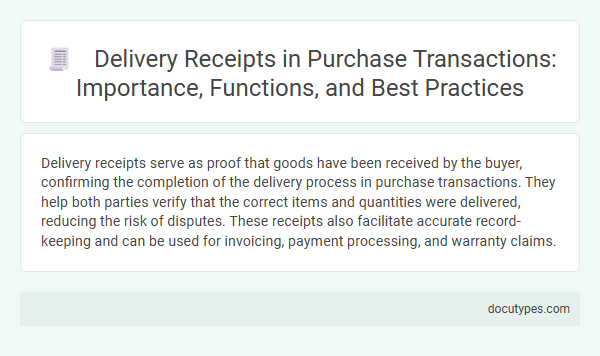Delivery receipts serve as proof that goods have been received by the buyer, confirming the completion of the delivery process in purchase transactions. They help both parties verify that the correct items and quantities were delivered, reducing the risk of disputes. These receipts also facilitate accurate record-keeping and can be used for invoicing, payment processing, and warranty claims.
Introduction to Delivery Receipts in Purchase Transactions
Delivery receipts play a crucial role in purchase transactions by serving as proof that goods have been transferred from the seller to the buyer. These documents help verify that the items delivered match the order specifications in both quantity and quality.
Your business can use delivery receipts to ensure accountability and streamline payment processes. They also provide a clear record that can be referenced in case of disputes or discrepancies related to the shipment.
Key Components of a Delivery Receipt
What is the role of delivery receipts in purchase transactions?
Delivery receipts serve as proof that goods or services have been received by the buyer. They help ensure accountability and provide a record for both parties to verify the details of the delivery.
What are the key components of a delivery receipt?
Key components include the delivery date, description of items delivered, quantity, and the recipient's signature. These elements confirm the transaction's authenticity and facilitate accurate record-keeping.
The Role of Delivery Receipts in Purchase Documentation
Delivery receipts serve as essential proof of goods or services received in purchase transactions. They confirm that the buyer has obtained the specified items, ensuring transparency and accountability between the seller and buyer. This documentation supports accurate record-keeping and facilitates dispute resolution in contractual agreements.
Importance of Delivery Receipts for Buyers and Sellers
Delivery receipts serve as essential proof that goods have been successfully transferred from the seller to the buyer, confirming the completion of a delivery transaction. They provide a tangible record that protects both parties in case of disputes regarding the condition or receipt of products.
For buyers, delivery receipts ensure verification of the items received, safeguarding against errors or damaged goods, which supports smoother returns or claims processes. Sellers benefit from delivery receipts by having documented evidence that shipments were fulfilled, aiding in inventory management and reducing liability risks.
Legal Significance of Delivery Receipts
Delivery receipts serve as legal proof that goods or services have been received by the buyer in purchase transactions. These documents help establish the transfer of ownership and confirm that the seller has fulfilled their delivery obligations. Courts often rely on delivery receipts to resolve disputes related to non-delivery or damaged goods.
Functions of Delivery Receipts in Order Fulfillment
| Aspect | Description |
|---|---|
| Proof of Delivery | Delivery receipts confirm that goods or services have been received by the buyer, serving as official documentation for both parties. |
| Verification of Order Accuracy | They verify that the items delivered match the order specifications, including quantities and product descriptions. |
| Record Keeping | Establish a formal record in purchase transactions, helping resolve disputes and track order history efficiently. |
| Facilitating Payment Processes | Delivery receipts enable timely invoicing and payment by confirming receipt, improving cash flow management. |
| Legal Evidence | Function as legal proof in cases of delivery claims or disagreements between the buyer and seller. |
| Customer Assurance | Offer your business transparency and accountability, strengthening trust in purchase transactions. |
Common Challenges in Managing Delivery Receipts
Delivery receipts serve as proof of goods or services received in purchase transactions, ensuring accountability and verification between buyers and sellers. Managing these receipts often presents challenges that can impact record accuracy and transaction efficiency.
- Misplacement of Receipts - Physical delivery receipts are frequently lost or damaged, causing difficulties in verifying transactions and processing payments.
- Inconsistent Documentation - Variations in receipt formats and incomplete information complicate recordkeeping and audit processes for companies.
- Delayed Submission - Late delivery receipt submissions hinder timely transaction reconciliation and delay resolving discrepancies between parties.
Best Practices for Creating and Storing Delivery Receipts
Delivery receipts serve as crucial proof of goods or services received in purchase transactions. They help ensure accuracy and accountability between buyers and sellers.
- Include Detailed Information - List item descriptions, quantities, delivery dates, and recipient signatures to provide clear transaction records.
- Use Consistent Formats - Standardizing receipt templates enhances clarity and reduces errors across multiple transactions.
- Store Receipts Securely - Maintain both digital and physical copies in organized systems for easy retrieval and verification when needed.
Leveraging Digital Solutions for Delivery Receipt Management
Delivery receipts play a crucial role in purchase transactions by providing proof of goods or services received. They serve as a critical document for verifying order fulfillment and initiating payment processes.
Leveraging digital solutions for delivery receipt management streamlines tracking and reduces errors by automating record-keeping. Digital delivery receipts enhance transparency and facilitate real-time updates between buyers and sellers. Cloud-based platforms enable secure storage and easy retrieval of delivery receipts, improving overall transaction efficiency.
What Is the Role of Delivery Receipts in Purchase Transactions? Infographic

